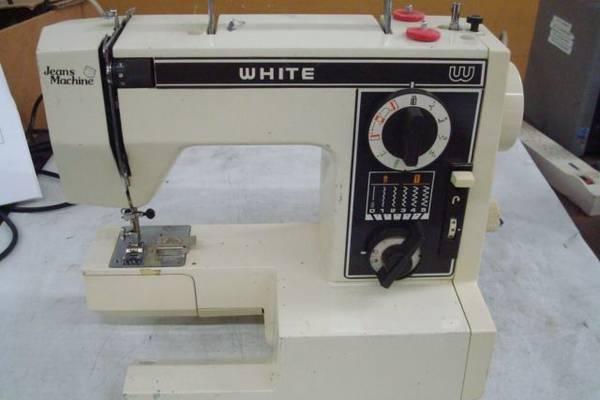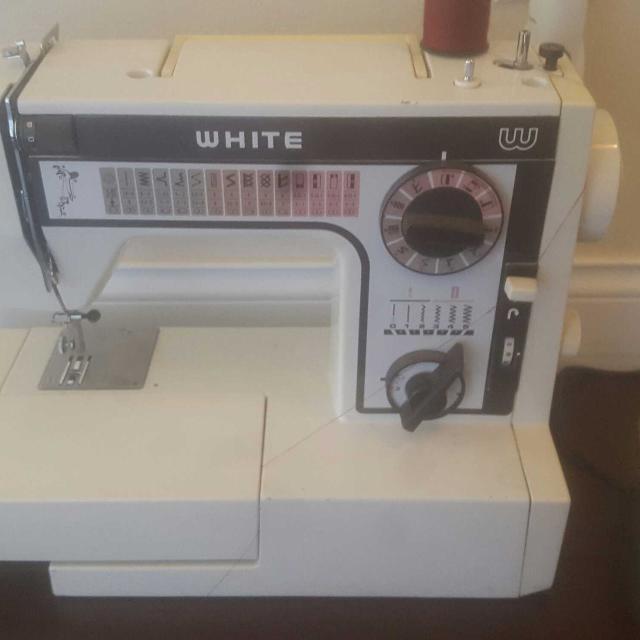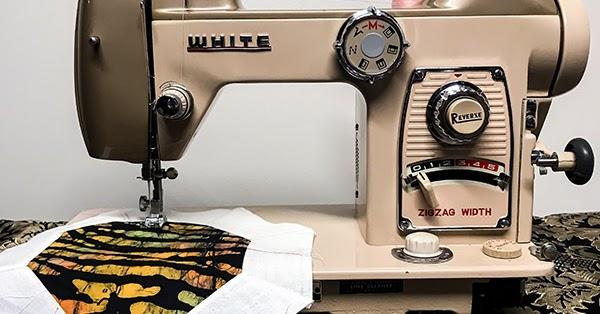Do not despair if you can’t remember how to thread the bobbin on your White sewing machine and have lost the instructions. The majority of White machines are constructed and operate in a similar fashion. Take remove the bobbin, wind it with your preferred thread, and put it back in the machine. From this point on, the procedure of threading it is simple.
- How To Hem Curtains Without A Sewing Machine? Step by Step Instructions
- How To Applique Letters With Sewing Machine?
- How To Sew Blanket Binding On Fleece? and Some Tips to Help You Tackle Mitered Corners
- How To Shorten Curtains Without Sewing? Complete Step-by-Step Guide
- What Is A Long Arm Sewing Machine? How Do You Use A Long Arm Machine?

Step 1
Make sure you hold the bobbin case with your left hand, with the hinged latch facing left, and the opening facing right. A three-inch spool of thread should protrude from the bobbin in your right hand as you grip it tightly in your left hand. The thread must be wound clockwise around the bobbin.
Step 2
Pull the thread through the slot in the side of the bobbin casing and into the bobbin.
Step 3
A tension spring can be found towards the end of the slot, so keep pulling the thread in that direction. Continue to pull the thread until it measures around 5 inches in length.
Step 4
All the needles should be up on the sewing machine.
Step 5
Make sure the thread tail extends down the right side of the bobbin case by holding the case by the hinged clasp. Turn on your sewing machine.
Step 6
The bobbin case must be fitted into the bobbin compartment in order to be used. Locate the little notch in the bobbin case’s lid where the lid goes onto the bobbin case. Turn over and fold the hinged latch into the bobbin casing. Retain the bobbins in their holder.
Step 7
Turn the hand wheel on the side of the sewing machine toward you by grabbing the top thread. Take care not to tug too hard on the thread as you turn the needle many times. The lower bobbin thread should rise as a result of this action.
Step 8
Begin sewing by bringing the upper and lower threads together and extending them towards the back of the sewing machine.
Tip
Match the thread color to the bobbin color. Raise the presser foot so that the thread can easily pass through the threading points. Adjust the tensioner based on the weight of the thread.
Warning
When threading a needle, do not use the foot pedal.
How Do You Set Up A White Sewing Machine?
- Connect the machine’s plug to the appropriate power source.
- When necessary, adjust the sewing speed.
- If you haven’t already done so, put the bulb in the face cover.
- Only use 120V screw-type bulbs and turn them in a clockwise direction to secure them.
- In order to insert the needle into the clamp as far as possible, you should raise the needle bar as high as you can.
- Secure the needle by tightening the needle clamp.
- Tension can be adjusted by turning the tension dial on the needle.
- The bobbin case screw allows you to fine-tune the thread tension.
- Press the inner pin for light to medium materials and the outer ring for heavy materials to adjust the presser foot pressure.
How to Date White Sewing Machine
Once you’ve mastered the technique, determining the age of a White sewing machine will be a breeze. In the 1960s, White purchased Husqvarna-Viking and continued to produce their machines under that additional name. This could cause some misunderstanding.
It’s not difficult; all you have to do is look for the manufacturer’s tag on your sewing machine. This tag might be located on the front, rear, bottom, or even on the motor of the machine.

White Jeans Machine Sewing Machine History
The history of the jean machine is difficult to disentangle from the history of all the other types White has manufactured. While it’s difficult to pinpoint exactly when and where each machine was manufactured and what technological advancements took place with 60,000 models being produced by the firm in 1882,
Xem thêm : How To Hand Sew Curtains? 9 Easy To Follow Steps For You!
According to user feedback, the White Jean machine remains a simple sewing machine designed to sew denim more easily than a standard sewing machine. Straight stitch was the only stitch option that came with them.
White’s lack of ability to handle thicker fabrics led many reviewers to purchase other brands of sewing machines that were better suited to their needs.
No one has documented a history of this particular sewing machine because the outcomes weren’t always adequate, which is why it hasn’t been mentioned before. Anyone who saw it didn’t think it was worth writing about because of its lackluster performance.
Who Made White Sewing Machines?
The White Sewing Machine Company was established in 1858 by Thomas White, who was its founder. After it was incorporated in 1876, it was renamed to the White Manufacturing Company.
Until roughly 1955, the company was operated by the Reddig family. After that, Edward Reddig took over as president and began making significant changes to the business. In 1906, the White Motor Company split off the company’s car-making operations and established an independent entity.
White purchased a number of significant appliance brands, including Kelvinator, Philco, and Westinghouse, over the years. White Consolidated Industries was renamed White Consolidated Industries in 1964 and purchased Frigidaire in 1975.
Does White Still Make Sewing Machines?
It didn’t exist when Electrolux bought it out in 1986. Despite the fact that White purchased Westinghouse from GM in 1975, the White Westinghouse trademark is not used to market their sewing machine lines.
Electrolux, on the other hand, uses the brand White Westinghouse, but not for their sewing machines. Brand name Husqvarna-Viking, which is associated with lower-quality sewing machines, is the moniker given to those machines.
Since 2006, the White sewing machine brand has not produced any new White sewing machines. SVP Worldwide owns Husqvarna-Viking, Pfaff, and Singer, and the Singer website has owner’s manuals for all of these brands’ sewing machines, including old Whites.
When Were White Sewing Machines Made?
An excellent time was had by the White Sewing Machine When the company was founded in 1858, it began producing the product. It lasted till 2006. The nearly 150-year history of sewing machines helped build some of the best machines ever made.
You may not have known this, but White also owned and manufactured a number of other sewing machines under other brand names. White survived after losing 40% of its business in the 1950s when it lost its contract with Sears by purchasing rival brands and manufacturing them under their own brand names.
Whites like Philco, Gibson, Westinghouse and Frigidaire retained their corporate identities despite their transformations. With Westinghouse, there was one notable exception: White-Westinghouse, which had its own brand name attached to it.
White Sewing Machine Value
The originality of a White sewing machine is a significant part of its worth. Adding a cabinet would raise the price a bit more than if it was only a carrying case.
The condition of the machine is also a factor in determining the value of a White sewing machine. Better condition means a higher price. Another thing to consider is how many machines were created and how many still exist at the time.

However, the worth is only as great as the customer is willing to pay for it. While certain Whites might fetch more of $300, the majority appear to be worth far less. There are three for sale on eBay for $300, two for $140, and one for $175.
If you have a White sewing machine that is in excellent condition and still works, you won’t be able to get a lot of money from it. Bad news: Models 1422 and 1717 are going for less than $50 on Amazon right now! The actual value is mostly unaffected by sentiment.
White Sewing Machine Serial Numbers
Xem thêm : What Is The Best Sewing Machine For Denim? Everything To Know!
You need to know the serial number of your White sewing machine in order to determine its age. There are a number of areas where the serial number can be found, and it may take a few seconds to find the exact location.
To find out what’s wrong with the machine, look at it from the front, back, bottom, or motor. It won’t take long to find the machine because it isn’t very big. The number should be written down in a convenient location once you get it.
Some serial numbers might be as little as seven digits long, depending on when they were made. If you want a complete list, you’ll need to get in touch with Husqvarna-Viking and request one.
How Much is a White Rotary Sewing Machine Worth
Unfortunately, there isn’t much positive news for you in this category. It is more valuable to own an antique White sewing machine advertisement than the real machine itself.
The value of a machine in an antique shop is based more on its historical significance than on the machine itself. Rotary sewing machines can be found on eBay for anywhere from $20 to $160.
Keep in mind that the sewing machine’s value can rise to $450 if it is sold with the original cabinet. However, each market in the country is unique, and the location of the seller has an impact on the price at which the item is offered.
a comparable gadget offered for only $155 in a different market In the end, the value is determined by what the market is ready to pay and bear.
Where Can I Buy a White Sewing Machine?
This list begins with a few places where you can get a White sewing machine for a reasonable price. If you’re looking for a bargain, you’ll want to check out thrift stores, estate sales, and yard sales.
If you’re lucky, you’ll be able to find a White at an auction house at some point. While you won’t make a fortune by selling your antique Whites on eBay, you can get some great deals if you’re looking to start a collection.
The next choice on this list is an antique shop, but be prepared to spend a larger price than you would for some of the other alternatives. The cost of repairing the sewing machine will be included in the selling price. As a bonus, they’ll be able to recoup part of their expenses and turn a profit.
It’s also a good idea to look for White sewing machines on sites like Craigslist and newspaper classified ads. Friends and relatives may be a useful source of information, but they may also be quite scarce.
It’s simple: If you’re looking for a current White sewing machine at a cheap price, just buy a Husqvarna-Viking model from the 1960s.
Make sure you know that the Husqvarna-Viking models are on the lower end of the quality scale.
Conclusion
The White Sewing Machine Company and sewing machines have a long and distinguished history. The company began manufacturing economical sewing machines in the nineteenth century, allowing even the most modest sewer to find some respite from their sewing tasks.
The good news is that if you can locate one of these vintage devices, many of their core components are still in working order. Sadly, White sewing machines weren’t up to the standards of Bernina.
Several sewers have expressed concerns about the quality of his machines, claiming that they are inferior to those of other manufacturers. Even if the end results are less than stellar, White machines are trustworthy and will get the job done.
Since the White brand was discontinued in 2006, you’ll only be able to find Whites under the Husqvarna-Viking moniker. There is no concluding chapter in White.
Nguồn: https://spasifikmag.com
Danh mục: Sewing Tips










